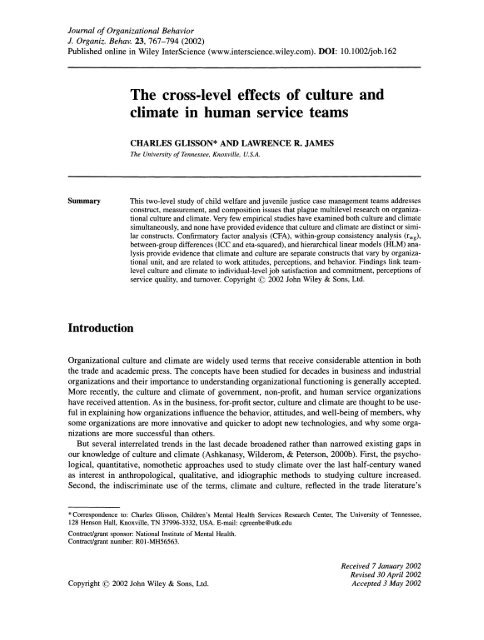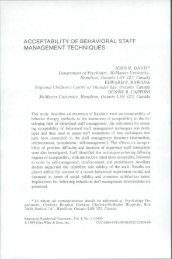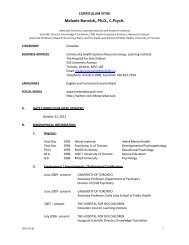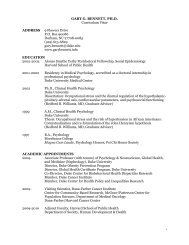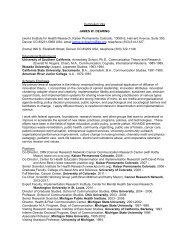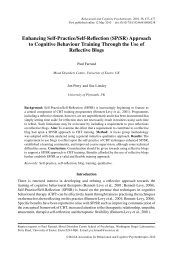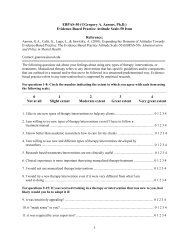The Cross-Level Effects of Culture and Climate in Human Service ...
The Cross-Level Effects of Culture and Climate in Human Service ...
The Cross-Level Effects of Culture and Climate in Human Service ...
Create successful ePaper yourself
Turn your PDF publications into a flip-book with our unique Google optimized e-Paper software.
Journal <strong>of</strong> Organizational Behavior<br />
J. Organiz. Behav. 23, 767-794 (2002)<br />
Published onl<strong>in</strong>e <strong>in</strong> Wiley InterScience (www.<strong>in</strong>terscience.wiley.com). DOI: 10.1002/job.162<br />
<strong>The</strong> cross-level effects <strong>of</strong> culture <strong>and</strong><br />
climate <strong>in</strong> human service teams<br />
CHARLES GLISSON* AND LAWRENCE R. JAMES<br />
<strong>The</strong> University <strong>of</strong> Tennessee, Knoxville, U.S.A.<br />
Summary<br />
This two-level study <strong>of</strong> child welfare <strong>and</strong> juvenile justice case management teams addresses<br />
construct, measurement, <strong>and</strong> composition issues that plague multilevel research on organizational<br />
culture <strong>and</strong> climate. Very few empirical studies have exam<strong>in</strong>ed both culture <strong>and</strong> climate<br />
simultaneously, <strong>and</strong> none have provided evidence that culture <strong>and</strong> climate are dist<strong>in</strong>ct or similar<br />
constructs. Confirmatory factor analysis (CFA), with<strong>in</strong>-group consistency analysis (rwg),<br />
between-group differences (ICC <strong>and</strong> eta-squared), <strong>and</strong> hierarchical l<strong>in</strong>ear models (HLM) analysis<br />
provide evidence that climate <strong>and</strong> culture are separate constructs that vary by organizational<br />
unit, <strong>and</strong> are related to work attitudes, perceptions, <strong>and</strong> behavior. F<strong>in</strong>d<strong>in</strong>gs l<strong>in</strong>k teamlevel<br />
culture <strong>and</strong> climate to <strong>in</strong>dividual-level job satisfaction <strong>and</strong> commitment, perceptions <strong>of</strong><br />
service quality, <strong>and</strong> turnover. Copyright ? 2002 John Wiley & Sons, Ltd.<br />
Introduction<br />
Organizational culture <strong>and</strong> climate are widely used terms that receive considerable attention <strong>in</strong> both<br />
the trade <strong>and</strong> academic press. <strong>The</strong> concepts have been studied for decades <strong>in</strong> bus<strong>in</strong>ess <strong>and</strong> <strong>in</strong>dustrial<br />
organizations <strong>and</strong> their importance to underst<strong>and</strong><strong>in</strong>g organizational function<strong>in</strong>g is generally accepted.<br />
More recently, the culture <strong>and</strong> climate <strong>of</strong> government, non-pr<strong>of</strong>it, <strong>and</strong> human service organizations<br />
have received attention. As <strong>in</strong> the bus<strong>in</strong>ess, for-pr<strong>of</strong>it sector, culture <strong>and</strong> climate are thought to be useful<br />
<strong>in</strong> expla<strong>in</strong><strong>in</strong>g how organizations <strong>in</strong>fluence the behavior, attitudes, <strong>and</strong> well-be<strong>in</strong>g <strong>of</strong> members, why<br />
some organizations are more <strong>in</strong>novative <strong>and</strong> quicker to adopt new technologies, <strong>and</strong> why some organizations<br />
are more successful than others.<br />
But several <strong>in</strong>terrelated trends <strong>in</strong> the last decade broadened rather than narrowed exist<strong>in</strong>g gaps <strong>in</strong><br />
our knowledge <strong>of</strong> culture <strong>and</strong> climate (Ashkanasy, Wilderom, & Peterson, 2000b). First, the psychological,<br />
quantitative, nomothetic approaches used to study climate over the last half-century waned<br />
as <strong>in</strong>terest <strong>in</strong> anthropological, qualitative, <strong>and</strong> idiographic methods to study<strong>in</strong>g culture <strong>in</strong>creased.<br />
Second, the <strong>in</strong>discrim<strong>in</strong>ate use <strong>of</strong> the terms, climate <strong>and</strong> culture, reflected <strong>in</strong> the trade literature's<br />
* Correspondence to: Charles Glisson, Children's Mental Health <strong>Service</strong>s Research Center, <strong>The</strong> University <strong>of</strong> Tennessee,<br />
128 Henson Hall, Knoxville, TN 37996-3332, USA. E-mail: cgreenbe@utk.edu<br />
Contract/grant sponsor: National Institute <strong>of</strong> Mental Health.<br />
Contract/grant number: R01-MH56563.<br />
Copyright ? 2002 John Wiley & Sons, Ltd.<br />
Received 7 January 2002<br />
Revised 30 April 2002<br />
Accepted 3 May 2002


